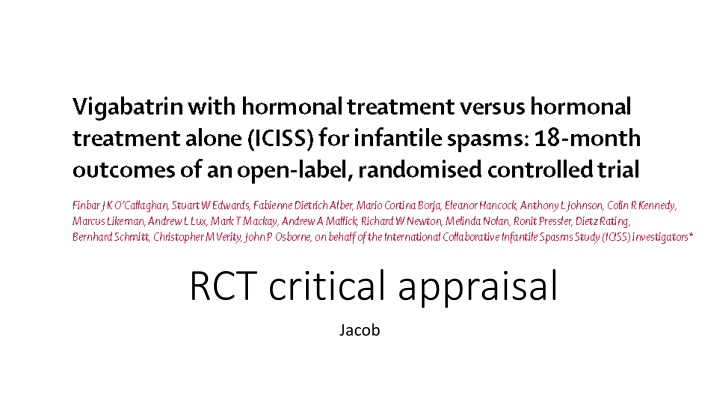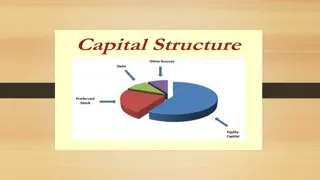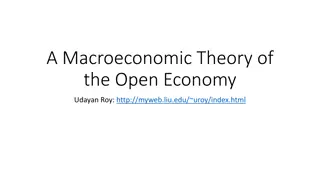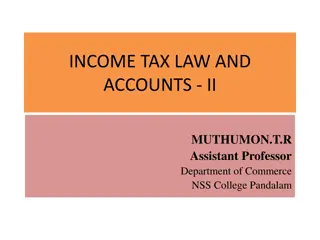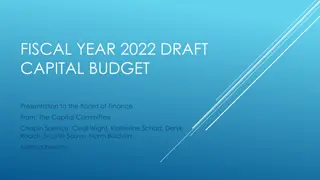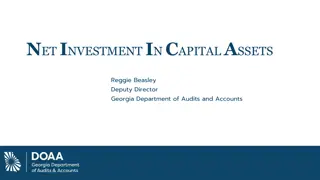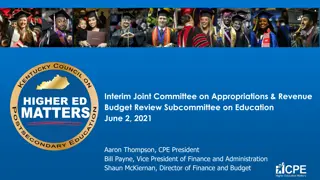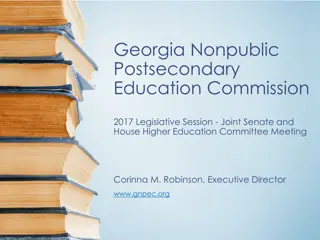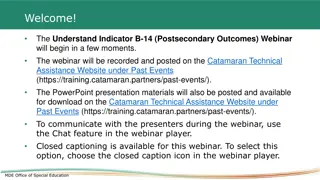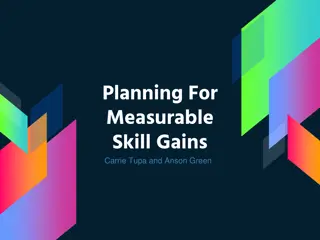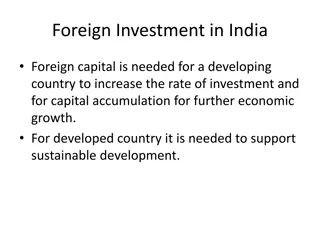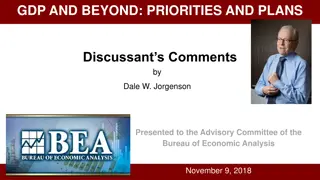2022-24 Capital Investment Priorities for Postsecondary Education
The document outlines the capital investment priorities for postsecondary education institutions, focusing on asset preservation projects, information technology projects, and budget priorities for the Council on Postsecondary Education. It provides background information on the institutions, recent progress, enrollment growth, research activities, and past investments in facilities. The content emphasizes the need for strategic planning and investment to meet the evolving needs of the education sector in Kentucky.
Download Presentation

Please find below an Image/Link to download the presentation.
The content on the website is provided AS IS for your information and personal use only. It may not be sold, licensed, or shared on other websites without obtaining consent from the author.If you encounter any issues during the download, it is possible that the publisher has removed the file from their server.
You are allowed to download the files provided on this website for personal or commercial use, subject to the condition that they are used lawfully. All files are the property of their respective owners.
The content on the website is provided AS IS for your information and personal use only. It may not be sold, licensed, or shared on other websites without obtaining consent from the author.
E N D
Presentation Transcript
RCT critical appraisal Jacob
Background Infantile spasms are a severe form of epilepsy They were the first described form of epileptic encephalopathy Affects approximately one in 2500 infants
Background The International Collaborative Infantile Spasms (ICISS) study is the first study to assess a combination of therapies (hormonal therapies plus vigabatrin) Between days 14 and 42 of treatment. This study shows combination treatment with vigabatrin and hormonal therapy is more effective than hormonal therapy alone
Question? Does a combination treatment of hormonal therapy plus vigabatrin show any difference in developmental or epilepsy outcomes at 18 months ?
Population: Infants with clinical diagnosis of infantile spasms by the local investigator Intervention: Prednisolone tablets or tetracosactide depot and vigabatrin Control: Hormonal therapy alone Outcome: Cessation of spasms, which was defined as no witnessed spasms on and between day 14 and day 42 inclusive from trial entry
Timeline: Recruitment commenced on March 7, 2007 till May 22, 2014 Study design: pragmatic, multicenter, parallel-group, open-label, randomized controlled trial From 102 hospitals (three in Australia, 11 in Germany, two in New Zealand, three in Switzerland, and 83 in the UK). The sponsor and funding sources of the study had no role in study design, data collection, data analysis, data interpretation, or writing of the report.
Was the study population clearly defined Inclusion criteria Clinical diagnosis of infantile spasms by the local investigator And an electroencephalogram (EEG) that was judged by local neurophysiologists to be hypsarrhythmic or similar, compatible with the diagnosis of infantile spasms
Exclusion criteria Age younger than 2 months or older than 14 months; Delay of more than 7 days since diagnosis Diagnosis of tuberous sclerosis Previous treatment for infantile spasms or previous use of hormonal treatments or vigabatrin co-incidence of another condition likely to be lethal before outcome assessment Difficulty with language used for assessment or participation in a concurrent trial.
Were the outcome measures clearly defined? Primary early outcome Cessation of spasms, which was defined as no witnessed spasms on and between day 14 and day 42 inclusive from trial entry, as recorded by parents or carers in a seizure diary. Primary late outcome Development at 18 months of age, as measured by the VABS composite score
Secondary outcomes at 18 months Presence or absence of infantile spasms in the preceding 28 days Presence or absence of any form of epileptic seizure in the previous 28 days Use of any anti-epileptic treatment (including ketogenic diet) in the previous 28 days
Were the patients randomized? Randomized by interactive computer system by the recruiting clinicians via the trial website. Patients were allocated in a 1:1 ratio to receive combination therapy or hormonal therapy alone. Randomization was stratified on two variables: presence or absence chromosomal abnormality or clinical syndrome, neonatal encephalopathy with seizures, and cerebral palsy or developmental impairment diagnosed before onset of spasms
Was the randomisation concealed? Yes it was concealed
Was the follow up complete? Yes follow up was complete
Were the patients analysed in the groups to which they were randomized? Yes, there were no cross overs
Were adequate number of people included in the study? Data from our previous clinical trial(UKISS) had a VABS composite score was 88 for those on hormonal treatments alone we judged that this score would need to improve by approximately half a standard deviation (ie, 7 points) on combination therapy to be considered clinically meaningful Number of patients required to see an improvement in mean VABS composite score from 88 to 95 in the subgroup with no identified cause, with a two-tailed significance level of 0 05 and 90% statistical power, would be 96 in each group or 72 in each group at 80% power
Decision was then taken to halt recruitment, given the disproportionate costs that would be required to extend the trial to recruit the number of patients needed to reach 90% power
Did the intervention and control groups start with the same prognosis? Baseline characters not available and appendix is not accessible
Validity of the study Study population: well defined Outcomes: clearly defined Randomization: Adequate Allocation concealment: done Blinding: open label Sample size calculation: Adequate but not achieved Intention to treat analysis: Not done Baseline characteristics: -
Results VABS mean composite scores did not differ significantly between the combination therapy group and the hormonal therapy alone group (73 9 vs 72 7, difference 1 2 [95% CI 4 9 to 2 6], p=0 55). Treatment modality was not significantly associated with epilepsy outcome at 18 months. Seizures were seen in 54 (30 0%) of 180 infants who received combination therapy and in 52 (29 2%) of 178 who received hormonal therapy alone (difference 0 8% [95% CI 8 8 to 10 4], p=0 90). Hence secondary outcomes were not looked
Were all clinically relevant outcomes considered? Yes
Were the study patients similar to the patients in my practice? Base line characters were not available Ethnic differences exist in the prevalence . Will there be a difference in treatment benefits- probably not Latitudinal differences on the global epidemiology of infantile spasms: systematic review and meta-analysis Jason L. Jia , Shiyi Chen , Vishalini Sivarajah, Derek Stephens and Miguel A. CortezEmail authorView ORCID ID profile
Conclusion Addition of vigabatrin with hormonal therapy does not improve the clinical out come of patients with infantile spasms
